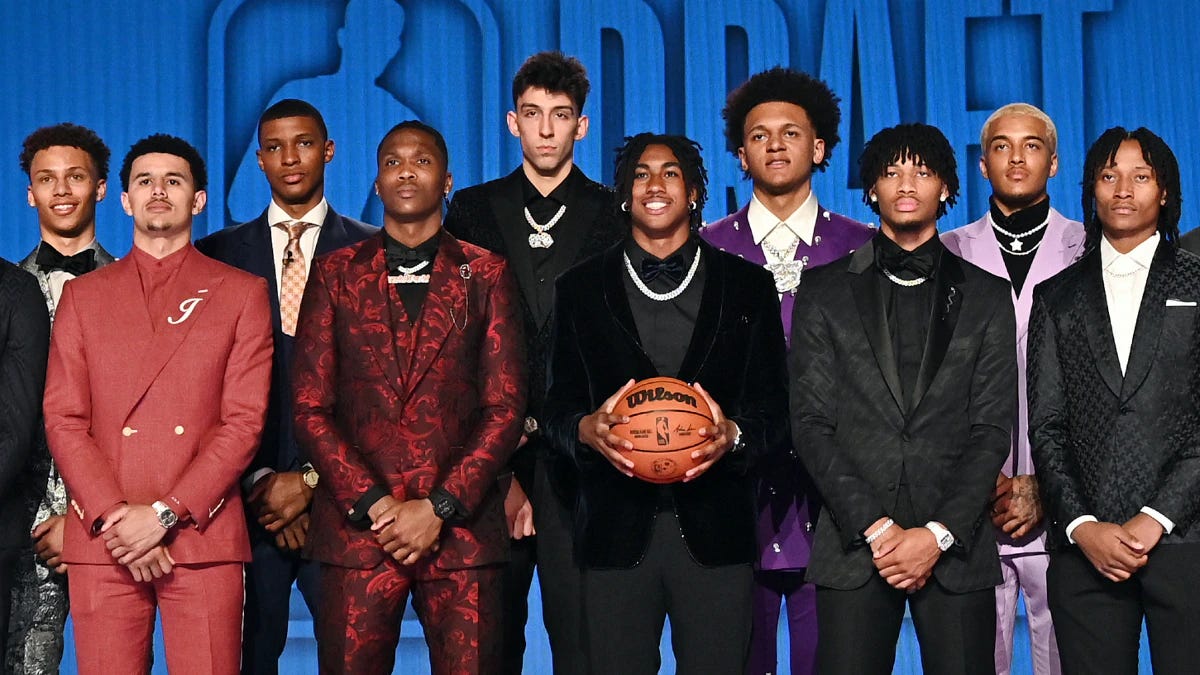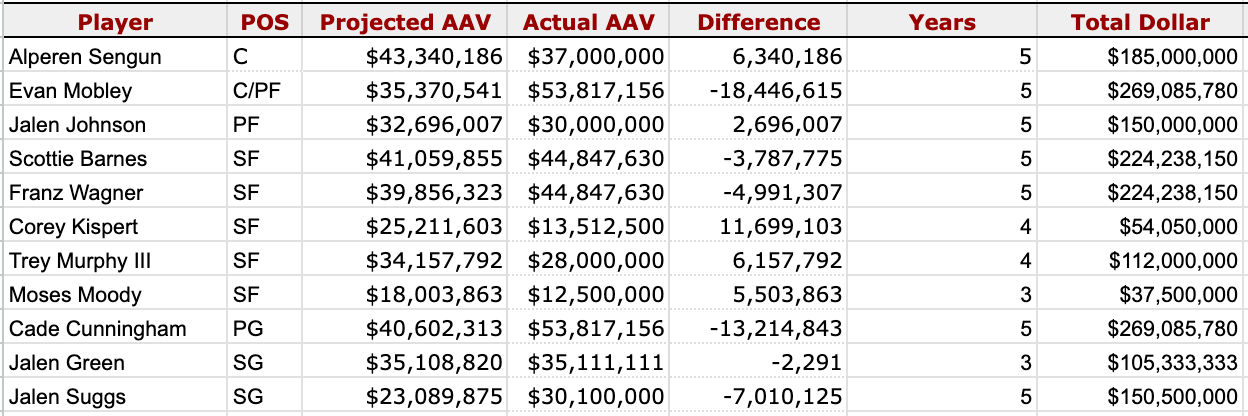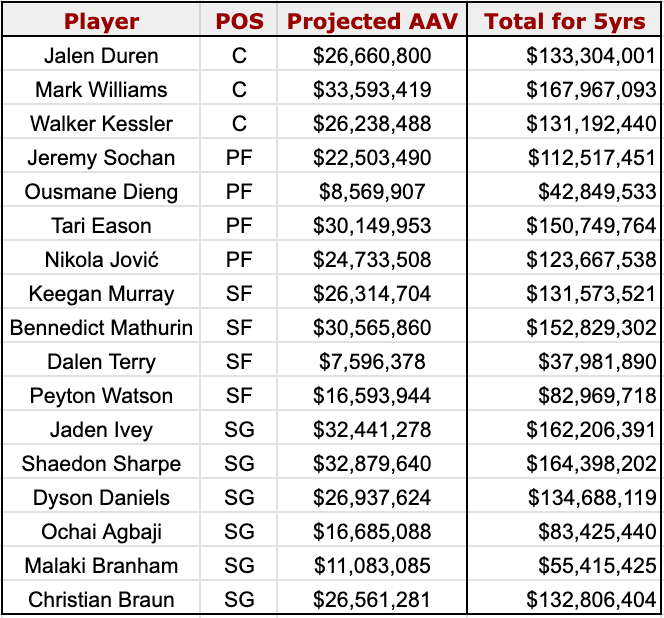Projecting the Remaining Rookie Scale Extensions
The NBA is all about extensions, and no extension is more fun than the rookie scale
The lifeblood of the modern NBA has become the rookie scale extension. Agreed upon following a player’s third season, these extensions allow players to finally get paid market value, while also giving teams the option of an extra season of team control (five versus four). Originally, designed to help teams retain the players they drafted (which it does), it also enables players to lock in generational financial security well before the age of 25. Of all the contentious clauses contained in the CBA, the rookie scale extension is certainly the most agreeable. When two parties’ incentives align, there’s usually a lot of agreement, and that’s exactly what rookie scale contracts achieve.
While it would be great if every player drafted received a rookie scale extension, that just isn’t reality. This offseason, the 2022 draft class is eligible for extensions, and nine players selected in the first round have already either had one of their rookie options declined, been waived, or are straight up out of the league. Of the 21 remaining first-round picks, a few won’t see eye-to-eye with what they’re offered and will opt to play out the final year of their rookie contract with the risk of hitting restricted free agency looming over them.
However, four players have already signed rookie scale extensions. Paolo Banchero, Chet Holmgren, and Jalen Williams all landed different versions of a maximum rookie scale extension, and Jabari Smith Jr., the third overall pick, landed in a five-year, $122 million deal. The top three picks, and the only player to already receive an All-NBA selection from the 2022 draft, have now locked in guarantees for the next six seasons.
These are exciting times for the Thunder, Magic, and Rockets, and that’s exactly what rookie scale extensions are about. It’s validation that your team made the right choice and that the future is bright. Now, the question remains: what will the 17 remaining first-round picks make on their rookie scale extensions?
Last offseason, I developed a relatively simple linear correlation model to project rookie scale extensions based on previous extensions, production, and positional classification. The exercise is not complex, but it did a very solid job. It pegged Franz Wagner, Scottie Barnes, Cade Cunningham, Trey Murphy, Alperen Sengun, and Evan Mobley as about max players, and it had Jalen Johnson and Jalen Green a bit behind. Sengun and Murphy didn’t land maxes, although they got decently close, but I think everyone agrees they’re on fantastic deals. Green’s projection ended up being spot on. It called for an annual average value (AAV) of between $33 and $36 million, and that’s exactly what he’ll be making the next three seasons.
Here’s how the projections did compared to reality.
First, defense-first players are much harder to project. Second, Mobley and Cunningham hitting their supermax criteria really make this look bad. And third, I shouldn’t have listed Kispert and Moody as small forwards. Out of the sample, I was off by about $1.3 million AAV, but if you reduce Mobley and Cunningham to regular maxes and switch Kispert and Moody to shooting guard projections, the projection looks a whole lot better.
What’s clear is that players who are close to a max value in the projections generally get the bump. The Rockets locking in Sengun for five years and $185 million and the Pelicans keeping Trey Murphy III at four years and $112 million will go down as the steals of the rookie scale extension window. If you’re wondering, points per game in a player’s third season is the single best predictor of their rookie extension with a linear correlation of 0.855 across all position groups. Due to that, it’s weighted much more heavily than any other metric. Now, before we check out the 2022 draft class projections, let’s take a look at the four guys who have already signed to see how it’s doing. As a reminder, the salary cap for 2026-27, when these contracts will begin, is projected for $165.5 million.
Honestly, I’m pretty pleased with these figures. Banchero has the easiest route to a supermax, which would see him land an AAV of $57.5 million, followed by Jalen Williams, who, should he make the third team All-NBA again, will have an AAV of $49.9 million. Holmgren is tougher to project as a defense-first player who has missed a ton of time, but his contract contains no supermax language. And Jabari Smith Jr.is also right in line with his projection. Here is the currently unextended class.
I want to add that Dalen Terry, Ousmane Dieng, and Malaki Branham will not be extended at these figures. Based solely on points per game, they would be projected for AAVs of $4.2 million for Branham, $748,471 for Terry, and -$1.4 million for Dieng. Certain rate stats are good predictors for salary, but oft-used players can rack up decent metrics despite being subpar players.
All told, I think I’d generally be comfortable with most of these contracts. Daniels and Braun will probably get closer to $30 million per season due to their defensive abilities, and I’m not sure Jovic will cross the $20 million per season threshold, even though he has been solid the past two seasons despite missing time. However, the two players that have caught my eye the most are Bennedict Mathurin and Tari Eason.
While Mathurin and Eason are both wings, they couldn’t be more different as players. Mathurin is an inefficient chucker who racks up points and little else, while Eason is a defensive playmaker who has some of the best advanced metrics in the 2022 class. It’d be a shock if Eason landed over $30 million a season, but I think he’d be worth it. Meanwhile, I consider Mathurin as a $20 million a season player, and that’d still be a decent bet on his development.
From what I can tell, when there is a big gap between the projections and the general consensus, deals don’t get done. The projections are based on the contracts that get signed, and the contracts that get signed indicate an alignment over a player’s value. For example, last season, the model said Cam Thomas was a max player due to his massive usage and points per game, and he has allegedly only been offered a two-year, $24 million deal from the Nets. If you think any of these figures look severely off, you’re probably right, and as such, a deal won’t come to fruition. I probably should try to fine-tune it, but that’s another project for another day.
For any inquiries about work, discussion, and the like, you can email me at nevin.l.brown@gmail.com.






